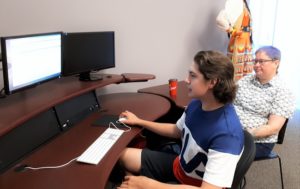More filmmaking workshops on the horizon as demand for First Nations film crews increases

By Colin Graf
AAMJIWNAANG FIRST NATION— A recent filmmaking workshop has inspired at least one young student to improve his skills on the way to start a career in film.
Zachary Wolfe, 15, of Kincardine, Ont., spent part of a July weekend learning how to use video editing software in the media room at the Maawn Doosh Gumig Community Centre with Toronto filmmaker Thirza Cuthand.
After an attempt to make his own movie with school friends on their own YouTube channel, Wolfe discovered how much fun it could be. Still, winter weather and other difficulties caused them to abandon the project. He’s convinced the techniques he learned at the workshop will make a difference and he will be able to take those ideas back to his friends for future projects.
Wolfe decided to come to the two-day workshop after his mother spotted an announcement online, he says. During the workshop, teens and pre-teens had the opportunity to learn video skills, camera operation, how to record sound and use lights, as well as editing techniques.
The workshop was sponsored by the Southwestern Ontario Independent Film Festival (SWIFF), which is now approaching its fifth year in Sarnia, Ont. SWIFF has been offering youth workshops in filmmaking techniques each year, says executive director Ravi Srinivasan, but this is the first time trying to specifically attract First Nations youth. The idea arose after Srinivasan discussed the absence of First Nations youth at the festival with SWIFF board member and arts organizer Candace Scott-Moore of Chippewas of Kettle and Stony Point First Nation. They decided to take the workshops directly to First Nations in their area, with Kettle and Stony Point and Walpole Island next on the list, with dates yet to be announced.
“Teaching video and film skills to First Nations youth is important to help Indigenous people tell their own stories to the world,” says Cuthand. “So much of film history has been settlers talking about Indigenous people…Indigenous people need to tell our own stories about our own lives in our own words.”
The number of Indigenous filmmakers and film technicians is growing across Canada, and there are more and more opportunities to screen original work, according to Cuthand, who grew up in Saskatoon. One example is the ImagiNative Festival in Toronto, which celebrates its 20th year this fall. Other Indigenous film festivals are starting around the world, even in London, England, she adds.
Cuthand realized the demand for Indigenous camera operators, editors, and other crew was growing when she recently worked on a film for the National Film Board. Organizers were hoping to get a complete First Nations crew, but couldn’t find enough people.
“That was actually kind of good,” explains Cuthand, as it means they are in heavy demand.
Cuthand feels that First Nations work is being screened in Canada much more in recent years, as interest and concern grows in the wake of the reports on residential schools and the Missing and Murdered Women commission.
“There is also a growing desire among First Nations to tell their stories,” she says. “So many people have told stories about us; now we can tell our own stories. I think people have really felt that there are things that have been missed in the stories that get told about our communities…such as looking at issues surrounding two-spirited people.”
Cuthand also finds the subject matter and approach to telling First Nations stories changes as Indigenous people take over their own storytelling. She says “more diverse genres” are turning up such as comedies or sitcoms like Mohawk Girls, and even horror films such as Jeff Barnaby’s Blood Quantum, a horror movie set in a Mi’gmaq community.
“There’s a bit more permission to be playful with the stories we are telling. We don’t always have to educate others,” she says.


